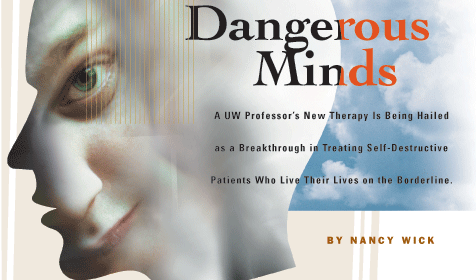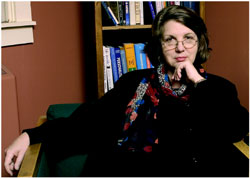

What Linehan believes is that the disorder arises from a combination of biological vulnerability—a hypersensitive temperament—and an “invalidating” environment, one in which caregivers don’t recognize or accept the child’s intense emotions. Although this often happens in an atmosphere of abuse and/or neglect, Linehan says it can happen in loving homes too, because these children require extra soothing and careful coaching in appropriate behavior.
“The problem with a difficult temperament child is, if the parent doesn’t do that, the child escalates,” she says. Naturally, when the child ratchets up the tantrums, the family moves to repress the emotion, and a vicious cycle ensues. As Linehan puts it, “The child creates the family and the family creates the child,”
When Linehan started her research back in 1981, she planned to treat suicidal patients with cognitive behavioral therapy, a method that emphasizes identifying and changing dysfunctional patterns of thought and behavior. But she quickly found that this did not work with borderlines. The problem, she says, is that standard cognitive behavioral therapy is a “technology of change.” Therapist and patient assess the patient’s faulty thought patterns and agree on reasonable steps for changing self-destructive behavior.
But this approach made borderline patients feel their suffering had been discounted. “They were really sensitive to being told they were the problem, because most of them had been told their whole lives that they were the problem,” Linehan says.
Moreover, people with borderline personality disorder usually have multiple crises in their lives, so when Linehan tried to zero in on one problem, they would threaten to kill themselves over some other problem. And they didn’t have the skills to follow through on what they said they would do to help themselves.

Faced with the failure of her planned approach, Linehan simply opened her therapy sessions to scrutiny. Her research team watched her through one-way glass as she met with patients and gave her feedback about what was working and what wasn’t. Slowly, through trial and error, she came to realize that what was missing was acceptance. She needed to show more acceptance of these people who had been discounted all their lives, and they needed to accept their miserable present and often tragic past long enough for the treatment to work.
Acceptance, Linehan knew, wasn’t the strong suit of Western thinking. Trained in a contemplative Christian discipline called centering prayer, she was familiar with Zen Buddhist thought, and in 1985 she used her contacts to arrange a most unusual sabbatical. She spent three months studying with a female Zen master at Shasta Abbey in California and an additional three with a Catholic priest who was also a Zen master.
“It was utterly clear to me afterwards that I had found what the patients needed,” Linehan says. “I just had to figure out how to teach it to them.”
Her patients, she knew, weren’t going to sit on a meditation cushion for hours. And because they came from a variety of religious traditions (or no tradition at all), she couldn’t use spiritual language when talking to them. She had to find a way to “take the Zen out of Zen.”
Ever the pragmatist, Linehan designed a training program for her patients that would take place outside therapy sessions. Meeting as a group, they would get lessons on ways to change their self-destructive behavior and would be assigned homework to practice the techniques. The core skill, the one that is offered first and pervades everything else, is mindfulness.
As Linehan explains it in her treatment manual, everybody has a reasonable mind and an emotional mind. In between the two is what she calls “wise mind.” Wise mind is a synthesis of reason and emotion, but with something else added, something she calls intuitive knowing. To reach wise mind, patients are taught “what skills”—observing, describing and participating—and “how skills”—taking a non-judgmental stance, focusing on one thing in the moment, and letting go of being right to be effective. Patients are taught, for example, to notice and describe their thoughts, and to recognize when they are interpreting reality rather than seeing it. They might be asked to carry a counter and keep track of how often they make such judgments. The skills training system is, in fact, built around diary cards that patients fill out so their progress (or lack of it) will be evident.
Go To: Page 1 | Page 2 | Page 3